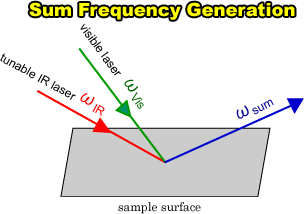
| MadSci Network: Physics |
The simple answer to this question is that photons really do collide and interfere with each other they just do it very quickly and it is very difficult to detect. They do not scatter off each other however since they can only exchange energy and momentum when in a medium. I guess a simple explanation for this is that there is no particle present vacuum to mediate photon-photon interactions, or at least not one that we have detected yet.
The question of photon interaction always stimulates an interesting and usually heated debate. I have heard professional physicists arguing over this one and it usually comes down to people's definitions of what interaction exactly is. Paul Dirac, one of the fathers of quantum theory writes in his book entitled "Principles of Quantum Mechanics" (I am pretty sure it is this book - I don't have a copy on hand) that photons do not interact with each other. This is what is usually quoted in answer to this question. I, personally, think that this is quite wrong, but only since I can benefit from another 74 years worth of research since he wrote those words. I quote Einstein: "We are standing on the shoulders of giants". Dirac developed a new mathematical formulism for describing nature at the quantum mechanical level when quantum mechanics was at the developmental stage. He was certainly no idiot, just not in possession of all the facts in the 1920s and 30s.
Sadly, these few words have lead to a great deal of discussion on the subject. I figured that this discussion was probably to be found on the internet too and a quick Google search revealed some interesting answers which I think are pretty good:
http://www.physlink.com/ Education/AskExperts/ae480.cfm
http:// astro.umsystem.edu/atm/ARCHIVES/AUG96/msg00519.html
And then there are those which are pretty bad (in my opinion). The moral of the story is don't believe everything you read on the internet. Even this posting since it is just the opinion of one physicist. We all have slightly different training, different backgrounds and have often inherited the prejudices of our teachers.
Here are my thoughts on the subject:
Firstly, we know that light can certainly interact in a medium. In a vacuum it is more tricky, but we will come to that in a minute. Light interacts with things like glass, water, silver, wood etc. We see it refract, scatter, reflect (sometimes favouring different colours like the reflection from gold) and it is emitted from materials like in a light bulb or LED. No surprises there. Now, in some materials, which are often called non-linear optical materials for reasons that I am not going to go into, light can be seen to interact with itself. For example, if I send an intense pulse of near infra-red light onto a crystal of quartz at the same time as a send in a red pulse I can, under certain conditions (usually getting the angle between the beams correct and having enough power) get blue light out the other side. This is a process of frequency conversion. I am taking the energy of the photons in the IR pulse and am adding this to the energy of the photons in the red pulse to get out blue. This interaction was first shown in 1961, and was no surprise even then, since this is an effect called frequency mixing which was very common in analogue electronics.

Now you might say that I am cheating using a medium in which to "collide" my photons since what is really happening, you could argue, is that photons are being absorbed by the material (or at least interacting strongly with the electrons in some way) and it is the electrons which are adding up the photon energies and emitting blue light. Well, I think you have got me, since I can't really argue with that. Nonlinear optics requires a medium which has a strong optical response. I.e. the electrons have to be highly polarisable. No medium, no mixing.
Now let us go back to what happens in a vacuum. This is where things get a little tricky. I am, of course, going to cheat a little. Let us go back to a medium for a short time because we have a problem with looking at photons interacting when they collide with each other. It is a pretty fast phenomenon. In fact, it happens at the speed of light. The easiest way to see interaction is to have the two photons going in the same direction so that they are sitting on top of each other. The only way to do this, unfortunately is to send them to a beamsplitter which is just a mirror which is 50% reflective and 50% transmissive. The good thing is that, when two photons "hit" each other on a beamsplitter they don't change colour. However, they do interfere. Interference is a very familiar thing in physics, especially optics. If two light waves of the same frequency, and now we are thinking in a "classical" manner where light travels as a wave, hit a beamsplitter at the same point then they interfere just like sound waves or water waves. In some places there are troughs and in some places there are peaks. This phenomenon has been well known for a couple of centuries. A typical interference pattern you might see with a laser is shown below
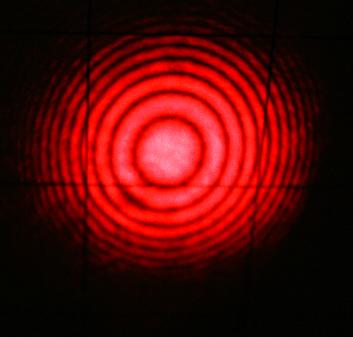
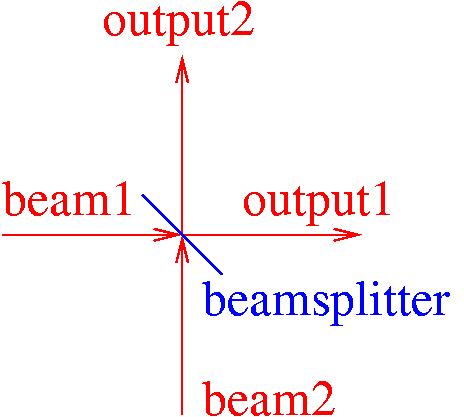
An important point here is that when the phase difference between the two incoming beams is correct and the middle of the interference pattern is black in output beam 1, the power is not lost since the middle of beam 2 is bright. Intensity, and therefore number of photons, is conserved. Coming back to the medium problem, we can make the beamsplitter as thin as we like and still have the effect. We are limited to one atomic layer in this case, but we could definitely think up different experiments where the interaction was not at the beamsplitter, but separated a long distance away in space. The theory that we use to describe this effect certainly has no requirement for a beamsplitter - it is just a convenient tool for bringing the two beams together.
Anyway, this is purely classical wave theory and there are no surprises, so you might say that I am tricking you and that the photons are not interacting - this is just interference, a mathematical trick. So let us think what happens with just a pair of photons coming onto this beamsplitter. Well, this time we have to do some hard mathematics which I am not going to bore you with, but it turns out that the result is just the same. If the phase is correct between the two photons (remember that you have to think of them as both particle and wave (or possibly neither particle nor wave, but definitely not one or the other)) then either both photons with go one way (i.e. into output 1) or both photons will go the other way (into output 2). Sounds crazy, but when you try the experiment, and I have, it is true!
Now, and this is where it gets really interesting, what happens when we get more than one photon in each input beam of the beamsplitter? Well the first thing is that to see anything interesting we have to be able to count the number of photons that come out of the other side. This is not as tricky as it sounds. Luckily there are companies which sell devices for counting photons nowadays (they are certainly not cheap though). If you are interested then check out this site. Now let us go back to the pair of photon case. If we plot the probability of detecting a photon in each output beam as a function of the phase difference between the two photons what do we see? Here is a graph of the results (this is simulated, but I have measured it):
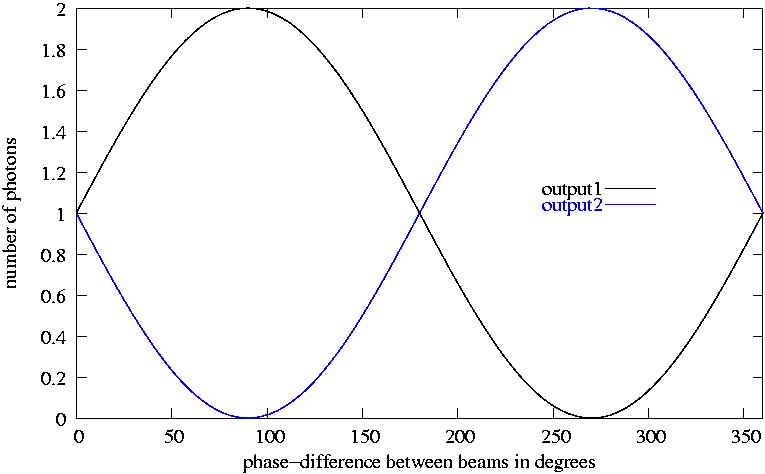
Now maybe you can see how this works a little better. When the phase difference between the two beams of photons is 90 degrees or 270 degrees then either both photons come out in output beam 1 (90 degrees) or both come out in beam 2 (270 degrees). If the phase difference is 0 or 180 degree then one photon comes out in output beam 1 and one in output beam 2. An interesting point here is that you don't know which input photon ends up in which output beam. If you could distinguish them in some way then you would always get one photon in each output beam regardless of the phase. (A feature of quantum mechanics.)
Okay, that was pretty bizarre, but now let us see what happens with two photons at each input. Now I shall cheat again slightly to make life easier for all of us and I have plotted the probability of detecting four photons simultaneously in either arm versus the relative phase of the two beams:
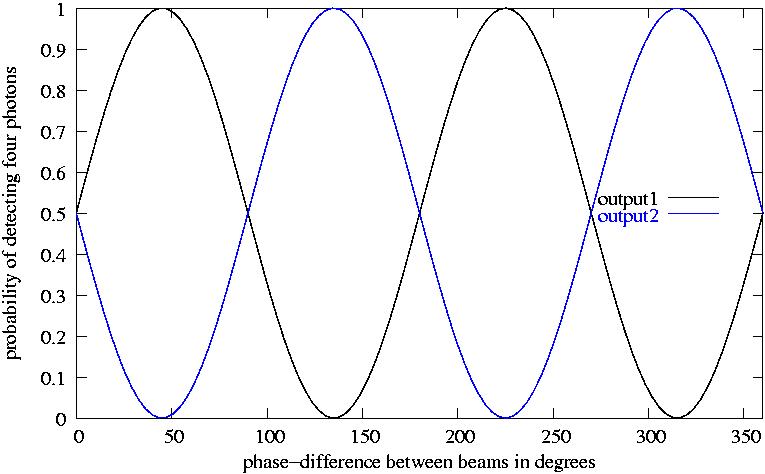
Now you can see that when we have two pairs of photons this interference has twice the frequency as for a single pair. If we now try it for three pairs the frequency is tripled and so on. This is no longer interference, but direct proof that photons do indeed interact and the interaction is dependent on the number of photons in the system, something that is not seen for any other type of wave. This sort of photon interaction has generated a new and brand new field of research which is commonly called quantum holography or quantum imaging where researchers are trying to use this interference effect to image objects much smaller than the wavelength of light, something which is impossible with "standard" light beams or lasers. You can read more about this at
http://www.aip.org/enews/physnews/2001/split/566-1.html
http://unisci.com/stories/20014/ 1126013.htm
http:// www.virtuallystrange.net/ufo/updates/2001/nov/m22-002.shtml
The conclusion to all of this is that photons are quite strange and, although not like solid matter where you can easily see collisions and interactions, still can interact and influence each other, given the right circumstances. I want to stress here a point which I kind of glossed over above and that is that the photons must have identical properties for them to interact fully. Partial interaction and brief interaction is allowed for non-identical photons though. The other thing that you should take from this is that you shouldn't believe everything that you read. Ask as many people as you can, read as much as you can with a critical eye and, better still, try it out for yourself!
Fun reading on a similar topic:
QED - The strange theory of light an matter (Richard P Feynman) An excellent non-mathematical and fun read from a master of explanation for the lay person
Try the links in the MadSci Library for more information on Physics.